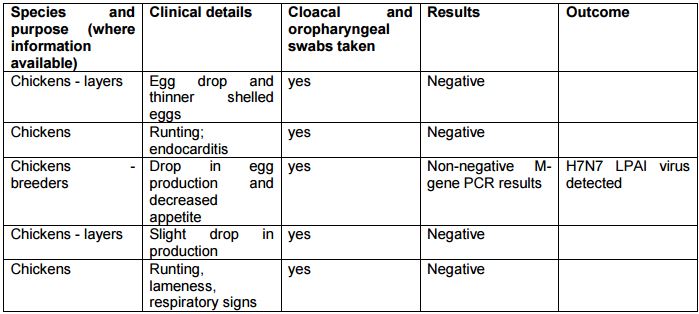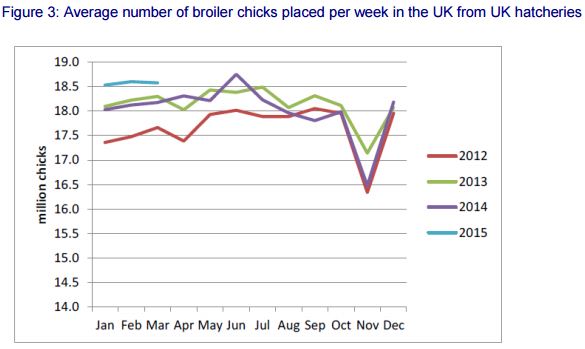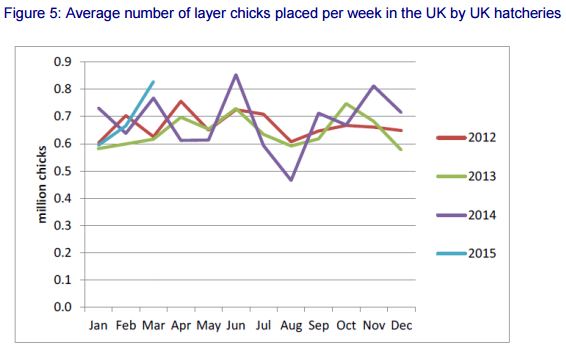



Emerging UK Avian Disease Threats: January-March 2015
Threats of avian influenza, colibacillosis and unusual diagnoses of leucosis are among the disease detections in this report from the Animal and Plant Health Agency (APHA), which looks back at disease threats emerging during the first quarter of 2015.ONGOING NEW AND RE-EMERGING DISEASE INVESTIGATIONS
Highly pathogenic and low pathogenic avian influenza outbreaks in Europe
During the period January to March 2015 outbreaks of H5N8 Highly Pathogenic Avian Influenza (HPAI) were officially reported in Europe in poultry flocks in Germany and Hungary. H5N1 and H5N8 HPAI infection were also detected in different species of wild birds in Europe.
Statutory sanitary disease control measures were implemented on all affected poultry holdings. No further outbreaks of HPAI were reported in the UK during this period.
Outbreaks of LPAI were officially reported in poultry flocks in Italy and the UK. The outbreaks are summarised below.
H5N1 HPAI was officially reported in two regions of Bulgaria. It was confirmed in a Dalmatian pelican, a rock dove, a black headed gull and in backyard poultry in January-February in the Burgas region and 21 Dalmatian pelicans were found dead, and H5N1 HPAI confirmed, in the Silsitra region in March.
In late March, 111 Dalmatian pelicans were found dead in the Danube Delta Biosphere Reservation in Romania and H5N1 HPAI was detected. A link without the outbreak in pelicans in Bulgaria could not be ruled out.
HPAI H5N8 was detected in February in a large indoor duck fattening unit in Hungary where the birds had clinical signs of nasal discharge, torticollis and increased mortality. The source of the outbreak was not established.
H5N8 HPAI was also detected in five mute swans found dead in central Stockholm, Sweden, in February-March. There were no commercial poultry holdings nearby. The virus was closely related to H5N8 strains circulating in Europe.
H5N8 HPAI was also confirmed in two backyard holdings a short distance apart in Western Pomerania, Germany, in January.
H5N2 Low Pathogenicity Avian influenza (LPAI) was recorded in ornamental birds and decoy ducks in two provinces in northern Italy in January-February (two regions) and H7N2 LPAI was recorded on a mixed species agritourism farm in a third province in March. The HA gene of H7N2 clustered with Eastern European and Asian strains circulating in 2010-2013 and the NA gene clustered with European strains circulating in Europe over the same period.
H7N7 LPAI was detected in a mixed housed and free range layer farm in The Netherlands in mid March and a similar H7N7 LPAI virus was detected at another farm in late March.
H7N7 LPAI was confirmed on a broiler breeder farm in England in January.
Cases of H5N1 HPAI have been reported in Israel, Palestine and Egypt. These isolates are distinct from those described above in Bulgaria.
During 2015 there have been outbreaks of H5N8 and H5N2 HPAI in North America (USA and Canada) in both wild birds (particularly in the Pacific flyway states) and commercial poultry, and H5N1 HPAI has also been detected in wild birds.
Co-circulation of multiple lineages and subtypes of H5 HPAI within different continents will likely result in further genetic diversity within this group of viruses with unknown implications for their maintenance and spread.
The increase in HPAI outbreaks, including activity associated with reassortant H5 HPAI strains circulating widely in China and South East Asia and the recent outbreaks in Northwest America and Northern Europe, emphasises the need for vigilance and increased biosecurity.
In the UK, Defra consider there to be a constant low risk of incursion of any notifiable avian disease into poultry throughout the year, and the recent situation in Europe means the UK is at an increased risk at present.
Therefore, all poultry keepers are advised to maintain robust biosecurity measures, vigilance for clinical signs of disease and to promptly report suspect cases of notifiable avian disease to a local APHA office.
Members of the public are also asked to remain vigilant for any wild bird mass mortality incidents and report these to the Defra Helpline: 03459 33 55 77.
Low pathogenic virus infection in UK
H7N7 LPAI was identified in January. The incident was identified as a result of the 12-month pilot scheme enabling private veterinary surgeons in Great Britain (GB) to request chargeable Notifiable Avian Disease (NAD) exclusion testing in chickens and turkeys (AHVLA, 2014; Gibbens and others, 2014).
This was the third of five exclusion testing investigations during Q1, the remainder of which were negative (Table 1).
The scheme is valuable in enabling LPAI to be investigated where it is considered to be a differential diagnosis in the clinical signs seen in birds on a site.
Table 1: Summary of findings from the pilot scheme for Notifiable Avian Disease exclusion testing scheme in Q1-2015.
Mortality in layers (differential diagnosis of exclusion testing case)
There had been ongoing concerns about increased mortality and some fluctuations in egg production in a 4,000 bird free range layer flock aged 47 weeks. Approximately 200 birds had been reported to have died in the previous two months.
Cannibalism and vent pecking were found during previous post-mortem examinations and Pasteurella species and Erysipelas species were isolated. The light intensity had been lowered to try to reduce the cannibalism.
Histopathology had described a hepatitis and splenitis consistent with the effects of bacteria and their toxins. Samples had been submitted to APHA the previous month for testing for exclusion of avian notifiable disease (Gibbens and others 2014) but no Influenza A viral RNA was detected.
Five birds were submitted for post-mortem examination. The predominant gross findings were egg peritonitis/salpingitis, and evidence of vent pecking and cannibalism both of which are often associated with egg peritonitis.
E. coli was isolated in pure growth from the reproductive tract of one bird, as is typical with egg peritonitis, and Pasteurella multocida was isolated in mixed growth from another bird.
No evidence was found of other underlying disease agents that could have accounted for the mortality.
E. coli infection - colibacillosis
E. coli infection (colibacillosis) is a common and economically important disease of poultry, affecting all sectors of the industry.
The manifestations of disease differ, and infections may be localized or generalised. The current pressure to reduce antibiotic usage (particularly prophylactic usage) across all livestock, to reduce the risk of antimicrobial resistance, is highlighting the need for a greater understanding of the epidemiology and pathogenesis of E. coli infections in poultry, as a means of more effective control of the disease.
The understanding of colibacillosis and avian pathogenic E. coli (APEC) in particular is being advanced by the use of molecular techniques, and a recent study of APEC in outbreaks of E. coli peritonitis syndrome (“egg peritonitis”) in layer and breeder chickens in the Netherlands has shown that one or two E. coli genotypes dominate in each outbreak (Landman and others 2014).
This greater understanding can allow more effective autogenous vaccines to be produced which may enable improved control of the disease on some farms. Several outbreaks of colibacillosis were reported by during Q1-2015, some examples of which are given below.
Localised colibacillosis in layers
An example of this is given in the preceding section under ‘mortality in layers’, and illustrates the involvement of other factors which appeared to have triggered the disease in this case.
Localised (yolk sac infection and omphalitis) and generalised colibacillosis (septicaemia) in broiler chicks
Yolk sac infection and omphalitis were seen in several submissions of broiler chicks aged between one and 14 days, with histories of increased mortality.
The findings on post-mortem examination in the younger chicks included inflamed navels (omphalitis), enlarged livers and spleens, yolk sac infection and occasional lung congestion, peritonitis and pericarditis.
In older submissions of chicks aged 12 to 14 days of age the pattern of lesions was more chronic and characterised by polyserositis affecting the hepatic capsule, pericardial sac and peritoneal serosae, indicative of septicaemia.
Routine cultures of livers, lungs, yolk sacs and spleens yielded pure growths of E. coli in chicks in all the submissions. The consistent finding of E. coli in these submissions illustrates the importance of this organism as a cause of ill health and mortality in the broiler industry.
Generalised colibacillosis: colisepticaemia in broilers and layers
E. coli septicaemia, abdominal cellulitis and septic arthritis were seen in a submission of 40-day old broilers submitted to investigate a history of unevenness and respiratory signs.
Post-mortem examination revealed variable lesions including swelling of the liver and spleen, abdominal cellulitis and occasional septic arthritis. Routine cultures of spleen and joints yielded heavy growth of E. coli.
Colisepticaemia was diagnosed in a 12,000-bird layer unit comprising two houses. There was an above expected mortality rate in one house at 25 weeks of age.
Ten birds had been found dead in the last five days with four deaths on one day. The birds were found dead with no premonitory signs. There was no apparent malaise in the rest of the flock. In general a 2 per cent mortality rate would be expected and currently the mortality was just above this.
There was also a drop in egg production, which fell by 2 per cent in two weeks from peak lay.
Four carcases were submitted, and showed gross pathology at post-mortem examination consistently suggestive of a bacterial challenge with evidence of peritonitis, pericarditis, and air sacculitis. Cultures of heart blood and lung confirmed pure profuse growths of non-haemolytic E. coli.
Outbreaks of colisepticaemia can be associated with both non-infectious and infectious trigger factors but these birds were comprehensively vaccinated so a viral incursion was not suspected and no specific underlying factor was identified.
There was also a positive response following the introduction of antibiotic treatment in this case.
Outbreaks of colibacillosis will continue to be monitored by means of scanning surveillance activities in poultry, and whether any new patterns of disease emerge.
Enterococcal and streptococcal infections in broilers
The increasing importance of enterococci and streptococci in broilers was reported in the Q2-2014 and Q4-2014 reports (anon 2014a, b). Chronic spondylitis – “spinal abscesses” were seen in a submission of 33-day-old broilers with a history of lameness.
Post-mortem examination revealed large ventral swellings of the spine centred on the body of the free thoracic vertebra “T4”. Bacterial cultures produced good growth of Enteroccoccus–like colonies with biochemical features consistent with Enterococcus cecorum, which is recognised as a cause of vertebral abscesses and osteomyelitis.
These organisms appear to be increasingly emerging as pathogens; their origin is unclear but may relate to hygiene issues in the hatchery (particularly in young chicks) or on farm.
Monitoring of this group of organisms by means of scanning surveillance will continue.
UNUSUAL DIAGNOSES
A variety of endemic poultry diseases continued to be diagnosed in backyard and commercial poultry during Q1-2015 in GB.
In these cases no wider threats were recognised and no specific actions required other than for producers and veterinarians to maintain vigilance for disease problems and investigate as appropriate.
Leucosis in chickens
Various manifestations of leucosis can be seen in chickens, associated with different retroviruses. Two examples of cases seen in Q1-2015 are given below.
A seven-month-old hen was found unable to support its weight or use its wings despite being apparently normal the previous day. It deteriorated quickly and was reported to convulse prior to death. No other losses were reported in the backyard flock of 15 birds.
There was green staining around the vent and a small amount of green liquid within the crop. The gizzard was empty. There was pericardial effusion and a small amount of straw coloured ascitic fluid. The liver and spleen were massively enlarged with indistinct <1mm, white spots on the latter.
Histopathology confirmed a diagnosis of erythroblastosis with suspected concurrent myeloblastosis. This condition is due to infection with an avian leucosis virus which is most likely to be transmitted vertically through the egg although horizontal transmission between birds is also possible.
Five other birds in the flock had been purchased from the same source and it is possible they may also be infected. In a separate case, fixed liver and spleen samples were received for histopathology from an adult chicken which was reported to have been found dead.
The histological diagnosis was a lymphoma and the appearance of the neoplastic cell population and the pattern of distribution were highly suggestive of lymphoid leucosis. This represents a different manifestation of leucosis and is likely to be caused by a different retrovirus.
Cases of leucosis in chickens will continue to be monitored by scanning surveillance, but at present they are likely to represent no more than sporadic occurrences.
CHANGES IN THE INDUSTRY, DISEASE PATTERNS AND RISK FACTORS
Broilers
There was a 2.2 per cent increase in the placings of broiler chicks from UK hatcheries during March 2015 compared with March 2014, and the average placings during Q1-2015 were 5.4 per cent higher than the preceding quarter (Fig. 3).
This represents a strong start in the first quarter of 2015 and puts the industry back on track for expansion. A downturn in 2014 was associated with restructuring of the industry in Scotland.
Turkeys
The numbers of turkey poults placed during March 2015 showed a decrease of 4.1 per cent compared to March 2014 (Fig. 4).
Layers
The number of layer chicks placed during Q1-2015 was 4.1 per cent lower than the corresponding figure for the preceding quarter, but the numbers placed in March 2015 were 7.8 per cent higher than in March 2014 (Fig. 9).
UK egg output in Q1-2015 was down 0.3 per cent compared to the preceding quarter 2.7 per cent higher than in Q1- 2014 (Fig. 5). Free range eggs accounted for 43.3 per cent of eggs packed in Q1.
The demand for eggs was good but egg prices were down compared both to the preceding quarter and the equivalent quarter in 2014.
Avian diagnostic submission rates and surveillance information will continue to be monitored to assess, where possible, the impact of economic and poultry demographic changes on scanning surveillance activities and endemic, exotic, new and re-emerging avian disease threats.
Further Reading
To view the carcase submission rates and other information, click here to view the full report.















